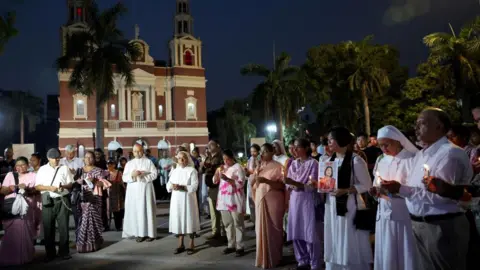The tragic plane crash involving Air India Flight AI171 has raised the death toll to a staggering 270 individuals, according to recent updates from medical professionals in India. The incident took place on Thursday, when the aircraft, which was bound for London, crashed into a residential area in Ahmedabad shortly after take-off. Out of the 242 passengers on board, only one survived—the 40-year-old British man, marking a heartbreaking loss for so many families.
In the aftermath of the crash, authorities have been working diligently to assess the total number of fatalities, specifically focusing on the potential deaths of individuals on the ground. Assistance with the identification of victims has involved the complex process of matching DNA samples, underscoring the tragedy’s scale and the grief that accompanies it. Vigils honoring the deceased have sprung up across major cities in both India and the United Kingdom, providing a space for communities to mourn, remember, and show solidarity with the victims’ families.
The investigation into this catastrophic event is being spearheaded by India’s Aircraft Accident Investigation Bureau (AAIB), which is receiving support from teams dispatched from both the United States and the United Kingdom. As part of their efforts to determine the cause of the crash, investigators made a significant breakthrough on Friday when they located a black box at the crash site. India’s Civil Aviation Minister, Ram Mohan Naidu Kinjarapu, stated that this discovery will “significantly aid the inquiry,” adding an essential piece to the puzzle as investigators seek to understand what went wrong.
The timeline of the incident reveals that less than one minute after departing from Sardar Vallabhbhai Patel International Airport in Ahmedabad, the aircraft began to lose altitude unexpectedly. The plane ultimately collided with a building designated for doctors’ accommodation at the BJ Medical College and Civil Hospital, an event that raises serious questions about aviation safety protocols and emergency response measures.
Dr. Dhaval Gameti, the President of the Junior Doctors Association at the medical college, confirmed on Saturday that the facility had received the bodies of 270 victims. This overwhelming number adds to the weight of this disaster, prompting a myriad of emotional responses from medical personnel and the public alike. The magnitude of grief felt across the community is palpable, as people come together to support one another during this difficult time.
The crash has elicited discussions regarding broader issues within the aviation industry, particularly concerning safety and regulatory oversight. Investigators will be examining various aspects of the flight operations, aircraft maintenance histories, and possibly human errors that could have contributed to this tragic event. With many eyes on the investigation, the ramifications of this crash extend beyond the immediate loss of life, touching upon public perceptions of air travel safety in India and globally.
As the situation unfolds, a continued emphasis on comprehensive investigations and victim support is paramount. The interplay between mourning, investigation, and policy reform is complex and will require thoughtful navigation as authorities seek answers and the community seeks healing.



